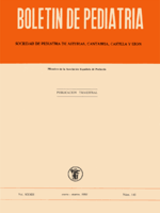Enfermedad meningocócica oculta en niños
M. Fernández González , M.T. García Muñoz , P. García González , J.L. Sánchez Badía
Bol. Pediatr. 1992; 33 (143): 67 - 72
De 105 niños con enfermedad meningocócica demostrada vistos durante un periodo de 10 años, no se sospechó la enfermedad inicialmente en 12 casos (11,42 %). No se encontraron parámeuos clínicos o analíticos predictores de meningococemia en un primer examen. Las petequias han hecho sospechar la enfermedad cuando ya se había establecido. Datos como fiebre superior a 38.5ºC, edad inferior a 2 años. elevado número de cayados en el hemograma y épocas con pico epidémico, nos deben alertar sobre meningococemia oculta, siendo necesario realizar hemocultivo a todo niño con fiebre alta así como estimular la detección del antígeno meningocócico para el diagnostico precoz de la enfermedad. Abstract The meningococcal infection was not diagnosed at the onset of the disease in 12/105 (11.42 %) children in which the infection was proved afterwards. Clinical and analytical parameters suggesting meningococcal infection were not found in a first examination and the petechiae were valuable only after the establishment of the disease. Fever higher than 38,5°C; age lesser than 2 years; high number of band cells and epidemic infection may suggest an unsuspected meningococcemia, being necessary to carry out an hemoculture in all children with high fever. The increase od the search of meningococcal antigen for the precocious diagnosis of the infection must also be estimulated.
\N
\N
Artículo completo (PDF) (389 kb.)
- Infectología
